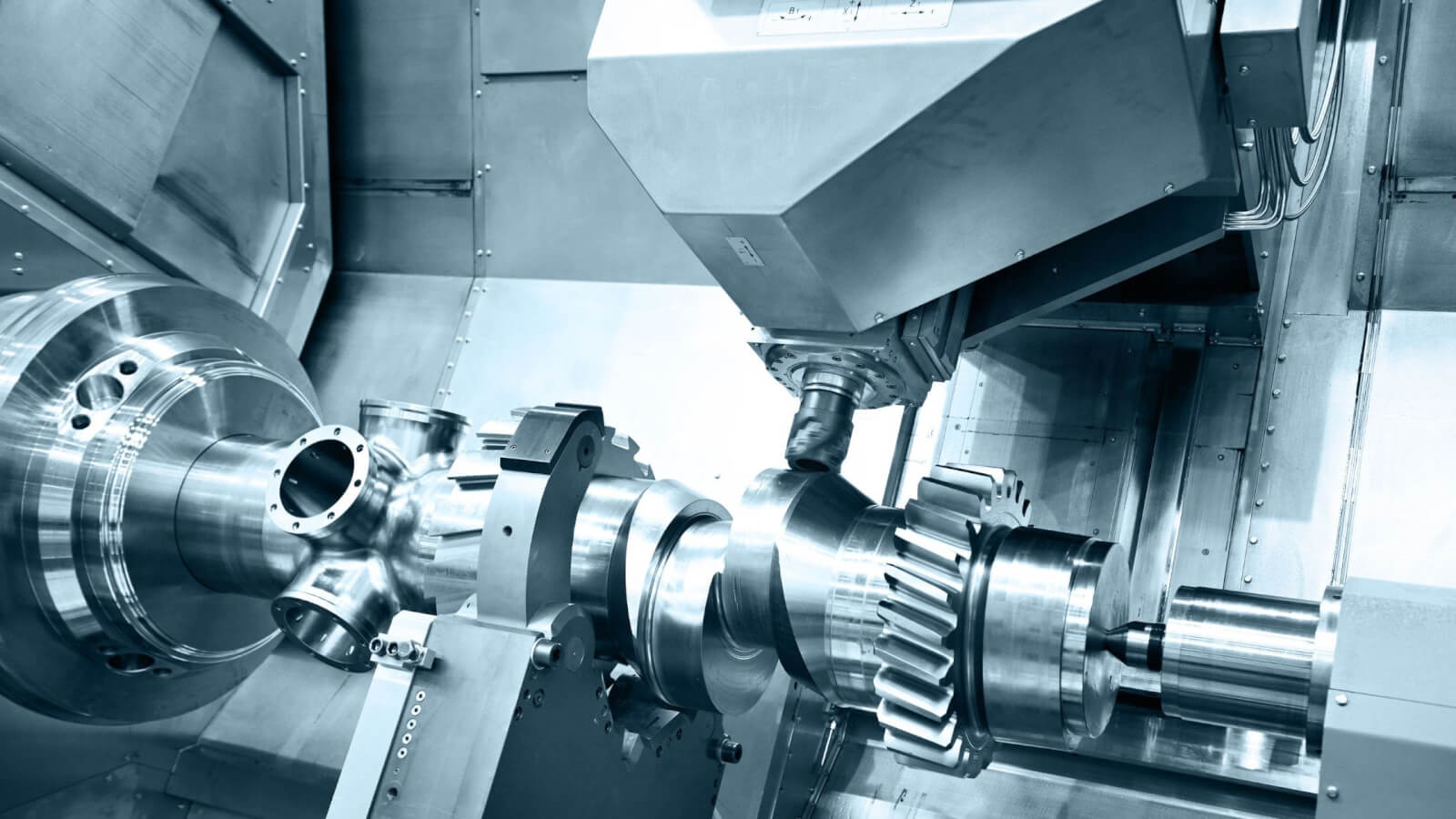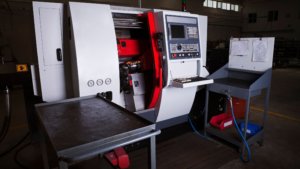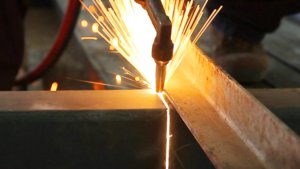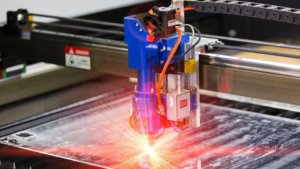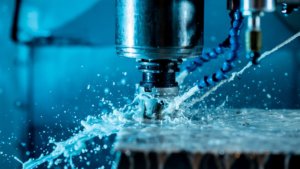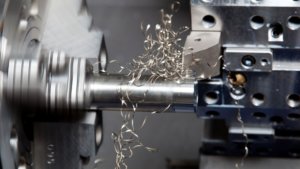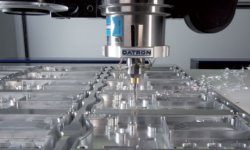CNC milling machines and Computer Numerical Control machining was the main pillar on which Industry 3.0 developed. CNC technology provides the opportunity for manufacturing processes that can meet astronomical production figures.
Due to the vast benefits of CNC technology, it finds applications in almost every manufacturing industry regardless of scale. Manufacturers are always looking for new CNC technologies that they can utilize to speed up production even more and save costs.
This article covers the different types of CNC machining technologies and the types of machines classified based on multiple factors.
Let’s dive into the topic right away:
What is CNC Machining?
CNC machining uses an algorithm written by designers to instruct the machine tools where to move and how to operate and control other secondary processes. A CNC machining process is highly scalable and can create anything from small electronic components to large-scale aircraft and aerospace parts.
What are the Different Types of CNC Machines?
As we will learn in later sections, there are multiple ways to classify a CNC machine. The most basic form is according to the design and function of the CNC machine. According to this classification, CNC machining is of the following types:
CNC Milling Machine
CNC milling machines use cutting tools to remove material from a workpiece and shape it accurately to the required specifications. The workpiece is usually fixed in location while the high-speed rotating cutting tool removes material from it.
CNC mills can have a wide range of cutting tools, each having a different purpose. Some typical cutting tools are end mills, reamers, face mills, taps, and drills. These machines come in both vertical and horizontal versions.
Applications of CNC Milling Machines
Some typical applications of CNC machining are:
- Cabinets
- Furniture
- Prototype models
- Signage
- Musical Instruments
Limitations of CNC Mills
CNC milling is a widely adopted technology since it fulfills its purpose successfully, providing high-speed manufacturing with precision CNC machining. Some of the factors that can be considered a limitation to certain users are:
- Size Limitation: Any particular CNC milling machine will have a limitation on the size of the part that can be machined using it. This size usually depends on the maximum travel distance of the tools and the size of the enclosure.
- Operator Skill: CNC mills require operators to have a good skill set. A small operator error can lead to significant deviations in accuracy and design problems in the later stages.
- Cost: Some users see the relatively high initial cost of a CNC milling machine as a limitation of the method. However, it should be noted that the high cost also brings several benefits, such as accuracy and precision CNC machining, which other alternatives do not provide.
Cost
When it comes to the cost of a CNC milling machine, the price range is more than you might imagine. There are significantly cheaper options for home use, as low as $10,000. On the other hand, it is common to see milling machines in production workshops costing over $200,000.
The hourly cost of CNC milling depends on the axis of the machine. A 3-axis CNC machine can cost around $40 per hour, going up to $200 per hour for a higher-axis machine.
CNC Router Machines
CNC routers cut various shapes and designs on flat surfaces of any material. These machines replace multiple manual tools traditionally used in carpentry and metalworking workshops, such as boring machine tools, panel saws, and spindle molders.
Applications of CNC Routers
Due to the ability of CNC routers to cut intricate shapes, the applications include:
- Carved wood furniture
- Moldings
- Interior and exterior decorations
- Door carvings
- Signage
- Musical instruments
Limitations of CNC Routers
- High noise: CNC routers usually consist of parts like a spindle, extraction system, and vacuum system. The overall operation of the machine can create a high noise level.
- Residual dust: The working environment of CNC routers contains a high amount of wood dust or metal dust.
Cost of CNC Routing Machines
On average, the initial price of the CNC routing machine varies between $3000 and $100,000. The hourly rates for CNC routing work are the same as a CNC milling machine.
CNC Plasma Cutters
A CNC plasma cutting machine delivers a highly accurate cut. It uses an electrical discharge arc (like a plasma torch) to ionize the air and melt the material where the electrical arc strikes. Since it works through an electrical arc, the process only applies to electrically conductive materials.
Applications of CNC Plasma Cutters
- Automobile manufacturing
- Automotive repairs
- Fabrication shops
- Salvage and scrapping
Limitations of CNC Plasma Cutters
- Materials: Plasma cutting only cuts through metals and conductive alloys. This limitation is a deal breaker for users who wish to machine materials like wood and plastics.
- Heat-Affected Zones: Plasma cutting is a hot-cutting process that works by melting the material. The heat leaves visible heat-affected zones (HAZs) on the cut area.
Cost of CNC Plasma Cutters
The initial cost of a CNC plasma-cutting machine lies between $12,000 and $300,000. The hourly cost of using a CNC plasma cutter is around $20 per hour.
CNC Lathes and Turning Machines
CNC lathe machines work by revolving the workpiece material around a central axis. Cutting tools are then applied to the workpiece to remove material and shape it into the required. A CNC lathe machine can produce a finished product much faster with more precision than manual lathes.
CNC lathe machines are ideal for various processes, like cutting, sanding, facing, drilling, turning, knurling, etc. In CNC turning, a non-rotary tool moves linearly on a rotating workpiece to create a helical/spiral cutting path.
Applications of CNC Lathes and Turning Machines
A CNC lathe machine finds applications in almost every manufacturing industry for making items such as:
- Camshafts
- Automobile parts
- Gun barrels
- Crankshafts
- Baseball Bats
- Musical instruments
- Dining tables
- Furniture legs
Limitations of CNC Lathes and Turning Machines
- Symmetrical Nature: Generally, CNC lathes can only create symmetrical components due to the way they shape materials. Therefore, these machines fail when custom, asymmetrical shapes are required.
Cost of CNC Lathes and Turning Machines
The initial price of CNC lathes starts at around $15,000 and rises depending on machine specs. The hourly rate for a CNC lathe starts at around $40 per hour.
CNC Laser Cutting Machine
CNC laser cutters use a highly focused laser beam to cut sheets of any material. A CNC laser cutter machine produces cuts with even greater precision than plasma cutting. CNC laser cutters are not limited to conductive materials, as solid-state lasers can cut any material.
Applications of CNC Laser Cutters
- Aerospace parts
- Automobile frames
- Medical Equipment
- Engrave materials
Limitations of CNC Laser Cutters
- Limited Thickness: Laser cutting machines are limited to the maximum thickness of the material you can cut with them.
- Technical Expertise: Laser-cutting machines require highly qualified operators to work with them. Laser-cutting machines can be potentially dangerous, so the operator must know how to control them as the laser beam moves over the workpiece.
Cost of CNC Laser Cutting Machine
The cost of buying a laser cutting machine can vary between $5000 and $300,000. The hourly cost of these machines is about $20 per hour.
CNC Electrical Discharge Machines (EDM)
An Electrical Discharge Machine (EDM) works similarly to plasma cutters by using an electrical arc to remove material at the required location. This method can create fast 2D cuts on metal sheet format.
Applications of CNC Electrical Discharge Machines
- Manufacturing Injection Molds
- Die Casting
- Blanking Punches
- Prototyping
Limitations of CNC Electrical Discharge Machines
- Material Constraints: A CNC electrical discharge machine works only for conductive materials. You cannot use this method for machining plastics, ceramics, wood, or other non-conductive material.
- Slow Cutting Rate: An EDM machine is very slow on corners and curves due to high electrode wear caused by recurring electrical discharges, leading to increased costs and slow overall production.
Cost of CNC EDM Cutting
The cost of a new EDM cutting machine starts at $15,000. The hourly cost of these machines is about $25 per hour, with the cost of electrode wire accounting for the most significant portion of the hourly cost.
CNC Waterjet Cutting Machine
A waterjet CNC machine uses a very thin jet of water to cut through the material. CNC water jet cutting is one of the most versatile methods due to its ability to work on any material. Multi-axis CNC water jet cutters are capable of 3D cuts as well. Additionally, the thickness of the material suitable for waterjet cutting is high.
Applications of CNC Waterjet Cutting
- Foam, paper, stone, ceramic, glass, and sheet metal cutting
- Mining
- Aerospace
- Automotive
- General Fabrication
Limitations of CNC Waterjet Cutting
- Cutting time: A CNC water jet cutter is slower than other alternatives. The speed is slower, especially around corners and curved cuts.
- Component Breakdown: Waterjet cutters work by using ultra-high-pressure jets. If using a low-quality waterjet system, there is a possibility of the cutter components breaking down.
Cost of CNC Waterjet Cutters
Waterjet cutters have a wide price range, starting at about $50,000 and going up to $200,000. The hourly cost of these machines ranges from $15 to $30 per hour, with the cost of abrasive material accounting for the most significant fraction of the total hourly cost.
CNC Grinding Machines
CNC surface grinders use rotating ceramic-blend grinding wheels to remove workpiece material for sanding, finishing, or polishing purposes. Diamond grinding wheels can provide exceptionally high-quality secondary finishing touches.
Applications of CNC Grinders
- High precision gear
- Automobile parts
- Medical equipment
- Aerospace parts
- Tooling
Limitations of CNC Grinders
- Slow Process: A CNC grinder precisely removes material, but at a slow rate, making it unusable for any application to shape materials and only works for finishing and smoothing out the surfaces.
Cost of CNC Grinders
CNC grinders are cheaper than other CNC machines. The cost of surface, roll or cylindrical grinders starts at $5000. The cost of operating these machines comes to about $20 per hour.
CNC Drilling Machine
CNC Drilling Machine
A CNC drilling machine is one of the most common types of CNC machining process in workshops. It is ideal for drilling holes in any material for screws, secondary assembly, or aesthetic requirements.
Applications of CNC Drilling Machine
- Automobile manufacturing
- Shipbuilding
- Astronautics
- Engineering machinery
- Mold making
- Woodworking and furniture making
Limitations of CNC Drilling Machine
Dimensions of the Hole: The dimensions of a hole by CNC drilling are limited, as this method cannot create deep holes or large holes. Additionally, different diameters of drill holes require specific-sized drill bits.
Cost of CNC Drilling Machines
The cost of CNC drilling machines is about $25,000 on average.
Automatic Tool Changer
An Automatic Tool Changer (ATC) is a variant of all common types of CNC machines. This ability allows for automated changing of the machine’s cutting tool, leading to faster production and less downtime.
ATC is used to switch the type of cutting tool in a CNC machine or to replace a broken or worn-out tool. It increases the degree of automation in the manufacturing process. Change of tooling is one of the major bottlenecks in most CNC machines, so ATC improves the capability of any CNC equipment.
Types of CNC Machines Based on the Number of Axes (Multiaxis machining)
Once the type of CNC machine is determined, the specific equipment can be further segmented based on the number of axes. Multiaxis machining is a type of CNC machining that utilizes multiple axes of movement in order to achieve complex geometries and tight tolerances.
For instance, a CNC milling machine can come in a 3-axis, 4-axis, and 5-axis variant, and the price and capability of each will vary drastically. Below are some of the most popular types of CNC machines.
2-Axis CNC Machine
2 axis CNC machines are the most basic CNC systems out there. They contain two axes of movement – the X-axis (vertical axis) and the Y-axis (horizontal axis).
These machines typically create simple straight-line cuts or drill holes on boards or machining of only a single surface of a workpiece without repositioning it. These machines work on a stationary workpiece.
3-Axis CNC Machine
3 axis CNC machines are the most common type of CNC machines. They have 3 axes of movement – the X, Y, and Z-axis (depth axis) and can machine the basic parts in 2.5 dimensions.
They can work on all six surfaces of a typically square or rectangular block of material, but the block requires repositioning. These machines also work on a stationary workpiece.
4-Axis CNC Machine
4-axis CNC machines are similar to 3-axis machines. Besides the three axes – X, Y, and Z, a 4-axis machine also contains an axis of rotation.
This axis allows the rotating cutting tool to move along the X-axis, known as the A-axis. The workpiece might also be moved along the same axis instead. These machines are ideal for making cutouts and cutting along an arc.
5-Axis CNC Machine
5-axis machining adds a pivoting motion of the cutting tool (or the work table) along the Y-axis. The axis of rotating and pivoting is called the C-axis.
These machines can create intricate and accurate parts due to the ability to work on five surfaces of a workpiece simultaneously without repositioning the work surface. The high accuracy makes these machines very useful in producing medical and aerospace equipment.
6-axis CNC Machine
A 6-axis CNC machine adds a third rotary direction to the cutting tool (or the workpiece), known as the B-axis. These machines can create shapes of any possible surface finish by involving all possible movement directions of the cutting tool and workpiece.
These machines are typical in the medical, aerospace, and military industries for precision applications (unless internal features are required).
7-Axis CNC Machine
7-axis CNC machines have 3 traditional axes involving the movement of the cutting tool, 3 axes for rotating the workpiece, and a seventh axis that rotates the arm holding the cutting tool. This axis is called the E-axis.
These machines often manufacture aerospace, medical, and military equipment due to the complexity of the parts they can produce.
9-Axis CNC Machine
9-axis CNC machines are a combined CNC setup of a 5-axis milling machine and a 4-axis lathe machine. The milling machine works on the surface to create the required surface finish, while the lathe completes the internal features of the workpiece. This way, a 9-axis machine can make both internal and external features of the part. These machines can make dental implants, surgical tools, and complex aerospace equipment.
12-Axis CNC Machine
12-axis CNC machines are the most complex machinery in the industry and may be overkill for most applications. These CNC machines contain two cutting heads that move in all 6 possible axes – X, Y, Z, A, B, and C. These machines exponentially increase the accuracy and can double production speed or even more.
Types of CNC Machines According to the Control System
The basic principle of a CNC machine is to move the cutting tool and the workpiece relative to each other. The cutter is constantly repositioned and taken to the required place. There are different ways in which tool repositioning works, leading to three different types of CNC machines:
Point-to-Point Positioning Control
A Point to Point (PTP) CNC controller is the most basic type of computerized numerical control system. In this control system, the cutting tool moves to a predefined point, after which the machining starts around the predefined cutting point.
PTP is the cheapest of all positioning systems, often used for drilling, spot welding, tapping, and reverting, where simultaneous positioning and machining are not required.
Straight Cut Positioning Control
A Straight Cut positioning control system can simultaneously reposition the cutting tool and machine the workpiece. However, the movement occurs only in parallel to one axis at a given time. The repositioning and machining are both done at a controlled rate. This control system is named so because the machining occurs in a straight line and curved cuts are not feasible.
Contouring Path CNC System
The Contouring Path CNC system is also called the Continuous Path CNC System. It is the most expensive of all three positioning control systems and can create the most intricate parts. These systems are capable of both PTP positioning and Straight Cut positioning. Additionally, they can control the cutting tool positioning in multiple axes simultaneously.
This versatility can create curved surfaces (contours) on the workpiece. CNC machines such as milling and turning employ this method for operation.
Wrapping Up
After reading all the information provided here, it is evident that there are almost countless types of CNC machines. It can be overwhelming to decide which CNC machine would suit your purpose the best. The harder choice comes after you decide on the CNC machine type you require; how to afford the high initial investment of the CNC equipment?
Fortunately, anyone can use the most advanced CNC machine capabilities without buying the machine itself. How? By outsourcing the CNC services to industry-leading experts such as 3ERP.
3ERP uses all possible types of CNC machines, from simple 3-axis machines for cheap manufacturing to multi-axis high-tech machines for the most intricate parts. Additionally, the specialized team of engineers can handle any requirement you throw at them.
To know how much CNC machining services will cost you, get in touch with the 3ERP team.
Frequently Asked Questions
How Many Different Types of CNC machines are there?
There is more than one common type of CNC machine due to the many different CNC machine processes, such as milling, drilling, laser cutting, EDM cutting, lathe work, and more. Every type of process has numerous options for axes and positioning systems, leading to a wide range of classifications. The best choice will depend on the accuracy required, job budget, and other factors.
What is the Most Popular CNC Machine?
There is a lot of variation in terms of size, functionality, and price. As a result, it can be difficult to determine which machine is the most popular overall as they serve different purposes. However, 3ERP uses the most popular CNC machines for a wide range of precision processes. The type of CNC machines used depends on each client’s needs. It is no surprise that 3ERP is one of the most popular CNC machine specialists in the market today.
